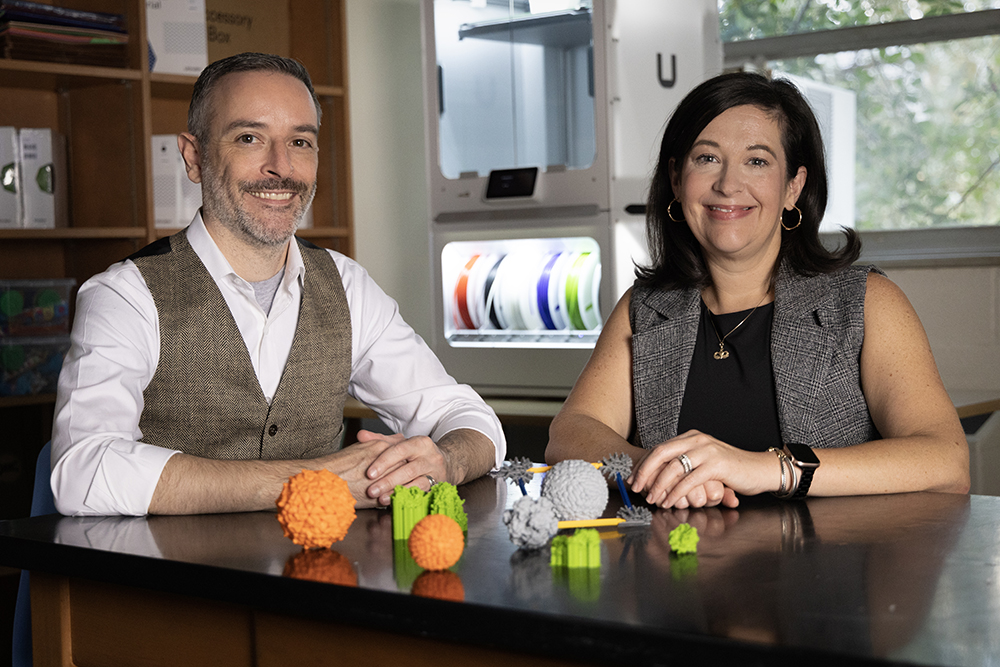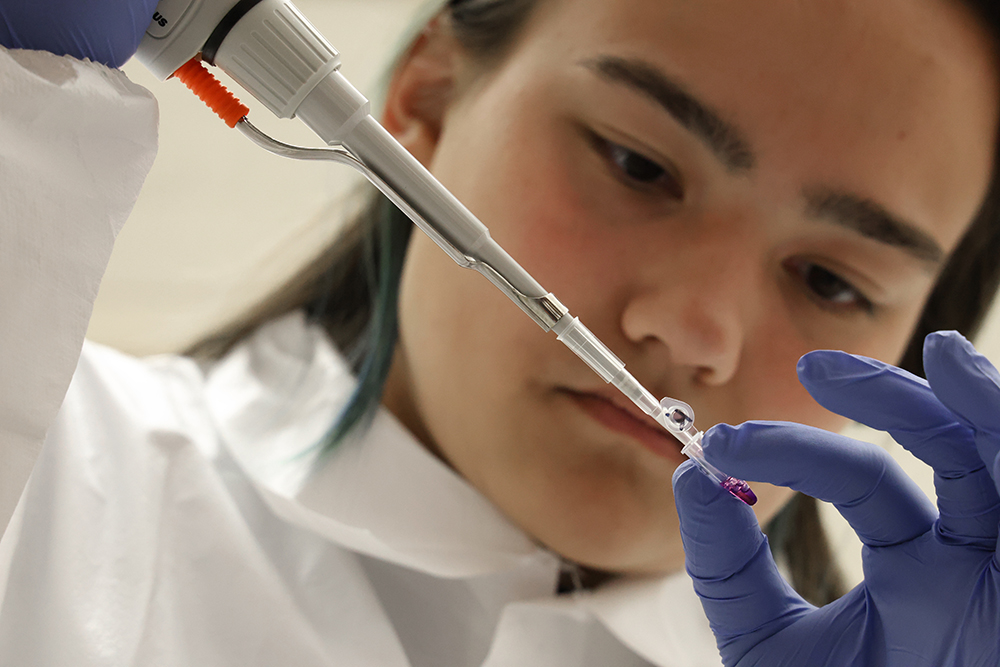Listen to the story below:
Each semester, on the first day of classes, Laura Ott and Eric Hastie kick off their biology classes in exactly the same way: by gushing over their passion for biology education research.
The field aims to improve learning processes and educational outcomes — and is fueled by teachers like Ott and Hastie, who want their students to engage with and succeed in biology. That’s why the duo cofounded the Carolina Biology Education Research (CBER) Lab.
In Fall 2021, as Ott gave her lively introduction at the start of her advanced cell biology class, Parker Shoaf’s ears perked up. The UNC-Chapel Hill junior would be student teaching the following year to earn his teachers’ license and was eager to hone his skills for teaching high school-level biology. He emailed Ott to learn more.
Shoaf became a peer mentor for Ott’s anatomy and physiology class and began helping her implement hands-on, in-class activities — like using 3D-modeling kits to construct complex carbohydrates to learn about the gut microbiome. Ott and Shoaf ran the activity just like they would an experiment, developing a set of research questions, providing students with surveys before and after the activity to assess their knowledge and engagement, and then analyzing the outcomes.
The goal? To improve biology curricula at Carolina.
Gaining hands-on experience
Growing up in the small, rural city of Lexington, North Carolina, Shoaf admits he had fewer educational opportunities than those from more urban areas. Many of his peers came to Carolina with extra credits from advance placement classes and experience working in labs, and he had less access to these resources.
Shoaf wanted to work in a lab, but he didn’t know where to start — until he took that advanced cell biology class with Ott.
In addition to learning basic research skills for the carbohydrate project, Shoaf collaborated with researchers at NC State to develop the modeling kits and gained hands-on teaching experience when running the lesson in the classroom.

Eric Hastie and Laura Ott co-founded the Carolina Biology Education Research Lab. (photo by Alyssa LaFaro)
“We had about 200 students in that class, and they enjoyed getting out of their seats and working with their friends,” Shoaf says. “They really engaged with that activity, manipulating the 3D-modeling kit to show how carbohydrates are built structurally to better understand the bond strength between them and to see how different microbes in the gut break them apart.”
Shoaf also co-wrote a paper on the project and its outcomes, which was published in Frontiers in Microbiology in December 2022. Upon its completion, he knew he wanted to pursue research going forward and wrote about the experience for his entrance essays into graduate school. Today, he’s a first-year master’s student in the biomedical research program at Wake Forest University.
Creating a classroom lab
Ott and Hastie started the CBER Lab to improve college-level biology curricula and help students like Shoaf gain research opportunities outside of lab spaces. With more than 2,800 majors, the UNC Department of Biology is the largest department on campus. This makes finding a position in a lab incredibly competitive — and a bit daunting.
“We have so many students, and they need research opportunities. Who cares if it’s in a classroom versus a lab?” Ott asks. “They’re still learning how to analyze data, formulate questions, and design experiments.”
Ott and Hastie are both teaching professors, which means they each teach three classes a semester — and are often responsible for upwards of 500 students. Next semester, they will have about 750. In addition to teaching, they manage teams of peer instructors, mentor students, and more.
Before coming to Carolina in 2020, Ott worked at the University of Maryland, Baltimore County as the director of the science education research unit, which focuses on improving student achievement in the sciences, technology, engineering, and mathematics. While this is where her formal training in education research stems from, Ott admits that she knew when she was a PhD student that lab science wasn’t for her.
“I was the graduate student that all of the undergraduates were sent to for mentoring,” she says, with a laugh. “I think my advisor saw something in me that I didn’t see in myself: that I liked teaching. I love research — solving problems, asking questions, learning new information, and analyzing data. But I found I could do research in the classroom. And the classroom is where I’m happiest.”
Hastie, on the other hand, loves working in the lab and spent most of his PhD program studying viruses to treat pancreatic cancer. He taught every semester of graduate school, trained teacher assistants, and spent summers helping Durham Technical Community College students gain lab skills and publish their findings. He also has a bachelor’s degree in journalism, which helps him communicate complex science concepts to his students and teach them how to do the same.
“I have always been inspired by undergrad lab education,” he says. “It takes them beyond that memorization step to really learn. They’re working on skills, they’re trying things out, they’re failing a lot. I love failure because it’s where you learn the most.”
Hastie also likes to experiment in the classroom. In 2021, he had his students create TikTok videos to unpack heady biology concepts for a lay audience. Ott loved the idea and decided to incorporate it in her biology honors class.
Together, they received a grant from the Institute for the Arts and Humanities to pursue the project and hired a science communicator named Raven Baxter — a.k.a “Raven the Science Maven” — to help the students produce their videos. They saw a noticeable increase in engagement and received a lot of positive feedback about the class.
“I realized how hard communicating to the general public is, but that is also why doing it is so important,” one student wrote in a post-course survey. “People have the right to know about science when it affects their life, and effort needs to be put in to allow the general public to have this knowledge.”
As Ott and Hastie continued to collaborate on projects, they wanted a physical lab space where their educational experiments could form and thrive. And the Carolina Biology Education Research Lab was born.
Training students to be researchers and teachers
When students apply what they learn in the classroom, they are more likely to retain that knowledge. Projects within the CBER Lab prepare undergraduates for future careers, help them engage with classwork, and then refine those classes to give all students the chance to participate in research.
For example, student researchers in the lab have been testing a module that focuses on fruit fly evolution in the classroom. They developed a lesson that includes hands-on microscope experience and dissection, lessons to help first years students get introduced to model organisms and inspire them to seek out lab opportunities. They gathered participants to test the module and are analyzing the outcomes to determine how it could fit into a larger lab course.
They also developed a lab about CRISPR, a gene-editing technology for modifying DNA, that will be offered in the course catalogue next year.
“These students are developing real research courses,” Hastie says. “And then we can hire them as teaching assistants so they can lead the course. It kind of gives them that next level of education. They did all the research and development, and now they’re the teachers.”
This is exactly what Hastie and Ott are striving for: a training ground for the next generation of student researchers and teachers. Additionally, they hope the lab provides students with a broader view of the careers they can pursue with a biology degree.
Shoaf, for example, was thinking about either teaching or medical school. But he liked doing research so much, that he decided to pursue a master’s degree in a research-based program.
“Getting the opportunity to work with Dr. Ott opened my eyes to everything I had been wanting during my time at UNC,” he says. “I had always wanted to be in a lab, but coming from a small rural high school I didn’t feel like I had enough experience to be competitive. Even though it wasn’t a traditional science lab, I still learned about hypothesis design, experimental design, and data analysis.”









